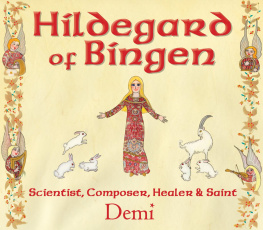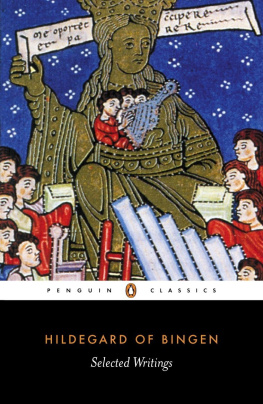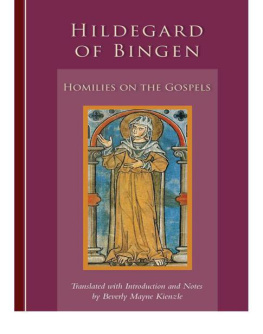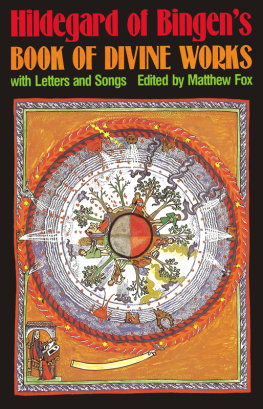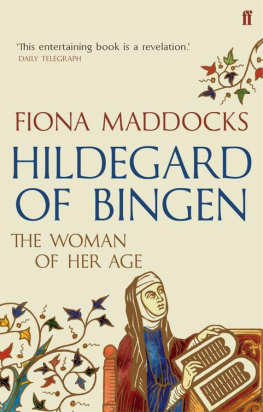Sabina Flanagan - Hildegard of Bingen
Here you can read online Sabina Flanagan - Hildegard of Bingen full text of the book (entire story) in english for free. Download pdf and epub, get meaning, cover and reviews about this ebook. year: 2011, publisher: Taylor and Francis, genre: Non-fiction. Description of the work, (preface) as well as reviews are available. Best literature library LitArk.com created for fans of good reading and offers a wide selection of genres:
Romance novel
Science fiction
Adventure
Detective
Science
History
Home and family
Prose
Art
Politics
Computer
Non-fiction
Religion
Business
Children
Humor
Choose a favorite category and find really read worthwhile books. Enjoy immersion in the world of imagination, feel the emotions of the characters or learn something new for yourself, make an fascinating discovery.
- Book:Hildegard of Bingen
- Author:
- Publisher:Taylor and Francis
- Genre:
- Year:2011
- Rating:3 / 5
- Favourites:Add to favourites
- Your mark:
- 60
- 1
- 2
- 3
- 4
- 5
Hildegard of Bingen: summary, description and annotation
We offer to read an annotation, description, summary or preface (depends on what the author of the book "Hildegard of Bingen" wrote himself). If you haven't found the necessary information about the book — write in the comments, we will try to find it.
Hildegard of Bingen — read online for free the complete book (whole text) full work
Below is the text of the book, divided by pages. System saving the place of the last page read, allows you to conveniently read the book "Hildegard of Bingen" online for free, without having to search again every time where you left off. Put a bookmark, and you can go to the page where you finished reading at any time.
Font size:
Interval:
Bookmark:


Second Edition

London and New York
First published 1989 by Routledge 11 New Fetter Lane, London EC4P 4EE
Simultaneously published in the USA and Canada by Routledge 29 West 35th Street, New York, NY 10001
First published in paperback 1990
Second edition 1998
Routledge is an imprint of the Taylor & Francis Group
This edition published in the Taylor & Francis e-Library, 2006.
To purchase your own copy of this or any of Taylor & Francis or Routledges collection of thousands of eBooks please go to http://www.ebookstore.tandf.co.uk/.
1989, 1990, 1998 Sabina Flanagan
All rights reserved. No part of this book may be reprinted or reproduced or utilised in any form or by any electronic, mechanical, or other means, now known or hereafter invented, including photocopying and recording, or in any information storage or retrieval system, without permission in writing from the publishers.
British Library Cataloguing in Publication Data A catalogue record for this book is available from the British Library
Library of Congress Cataloguing in Publication Data A catalogue record for this book has been requested from the Library of Congress
ISBN 0-203-00729-8 Master e-book ISBN
ISBN 0-203-17381-3 (Adobe e-Reader Format)
ISBN 0-415-18551-3 (Print Edition)
FOR MY MOTHER AND FATHER
Map of Germany showing places mentioned in the text.
The relics of one of the most remarkable women of the Middle Ages now lie in Rdesheim, a town on the picturesque middle reaches of the River Rhine, well known for its proximity to the Rock of the Lorelei and its extensive vineyards. Yet pilgrims do not continually flock to the parish church in Eibingerstrasse where the heart and tongue of St Hildegard of Bingen ( 1179) are preserved in a golden reliquary. Unlike the patient and self-effacing St Bernadette of Lourdes, or the surpassingly meek and ordinary St Theresa of Lisieux, Hildegard has not attracted a large popular following. Her virtues were indeed of a different order. There were limits to her patience, and her humility, though real enough, was of the paradoxical kind which gives authority and assurance. Meek and ordinary are the last words to describe her, as even slight acquaintance with her story will show.
Hildegard was born into a noble family in Germany in 1098. Although destined from an early age to live a life of total enclosure, literally walled up in her cell, she left its shelter to found her own convents at Rupertsberg, on the Rhine near Bingen, and later at Eibingen on the opposite side of the river. From Rupertsberg she corresponded with secular and ecclesiastical leaders, as well as a vast range of people of lesser rank and standing, and went forth as monastic troubleshooter, consultant exorcist, and visiting preacher. Had Hildegard confined herself to these activities she would have been unusual enough among the women of her day. But Hildegard was even more remarkable in producing an extensive body of writings. At a time when few women wrote as much as the occasional letter, Hildegards written works not only surpassed those of most of her male contemporaries in the range of their subject matter (from natural history, medicine, and cosmology, to music, poetry, and theology), but also outshone them in visionary beauty and intellectual power.
Hildegards achievements are thrown into prominence by the fact that, as an author, she stood virtually alone among the women of her time. Why do we have almost no other writings by women from this period? Even allowing for the ravages of time, deliberate suppression, or mere negligence, it seems that women were responsible for only a tiny proportion of the entire twelfth-century literary output. What were the factors, internal or external, overt or covert, which militated against women writers? How did Hildegard overcome them, and if she could, what prevented her female contemporaries from doing likewise? I hope some answers to these questions will emerge in the course of this book.
My own interest in Hildegard was first kindled over a decade ago by reading Peter Dronkes account of one of her poems. When I tried to find out more I discovered both that the field of her activities was much wider than I had imagined and that it had been only patchily cultivated. Although different aspects of her work had received varying amounts of attention there was nothing which gave a satisfactory overview of Hildegards life and work. I decided then that some day I should make a study of Hildegard for myself. Several years later I wrote a PhD thesis about some aspects of Hildegards prophetic persona. By the time this was complete, my own need for a general introduction to Hildegard had passed. Nevertheless there still seems to be some need for such a work, especially for those who are making their first acquaintance with Hildegard.
While microfilm and jet aircraft have facilitated antipodean study of medieval history, I have often felt disadvantaged by my geographical remoteness, not only from the subject of my study, but from others engaged in the same field. If we add to this the chronological and cultural distances, not to mention the religious distance between Hildegard and myself, the whole undertaking seems somewhat presumptuous. Yet in seeking to describe and understand what Hildegard was doing, being so far removed from the scene may have had some benefits. At least it means that there are no easy explanations waiting to be assumed, such as came so readily to some of her nineteenthcentury hagiographers. It may also make an overview easier to achieve, where those closer to the subject, in both senses of the word, may fail to see the wood for the trees.
A further objection to such an enterprise as mine might be raisedthat Hildegards writings have not yet been studied in sufficient depth to make a proper assessment of her place in medieval life and thought possible. Indeed, most of her writings still lack modern critical editions, the prerequisite for any such detailed study. Some of these are expected to appear in the next few years, but others are still so far from publication that they have not been assigned even a tentative date. Yet to put off writing about Hildegard for another decade at least would disappoint those who, having come in contact with this remarkable figure through her music, poetry, theology, writings on women or the natural world, now wish to find out something more. My intention, then, is to provide a comprehensive introduction to Hildegard, in the light of current scholarship, from which readers may be inspired to read, or even to produce, more specialized studies.
While Hildegards writings are remarkable in themselves, the question of how she came to produce her works and have them accepted by her contemporaries is almost more intriguing. I have tried in this book to give an account of both what she wrote and how she did it. Since even Hildegards major works are not well known or readily accessible, I have described them at some length. These descriptions form the central chapters of the book (chs 47). Here I have been more concerned to indicate the interrelations of her ideas and theories within the total body of her work, than to identify their possible sources or compare them with those of her contemporaries. To provide a general account of twelfth-century natural history, cosmology, or theology is beyond the scope of my book. The chapters on Hildegards writings are contained within an argument about how Hildegard was able to enter domains generally seen as the preserve of men, such literary activity being the major one. Those readers wishing to follow the sociological argument may thus go from chapter 4 to chapter 8 and then turn back to complete the picture with the account of Hildegards later writings. Those wanting to get an idea of the nature and range of Hildegards work could start with the central chapters. On the other hand, since the descriptions and the argument proceed more or less chronologically, the book can be read with profit straight through.
Font size:
Interval:
Bookmark:
Similar books «Hildegard of Bingen»
Look at similar books to Hildegard of Bingen. We have selected literature similar in name and meaning in the hope of providing readers with more options to find new, interesting, not yet read works.
Discussion, reviews of the book Hildegard of Bingen and just readers' own opinions. Leave your comments, write what you think about the work, its meaning or the main characters. Specify what exactly you liked and what you didn't like, and why you think so.



